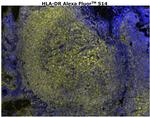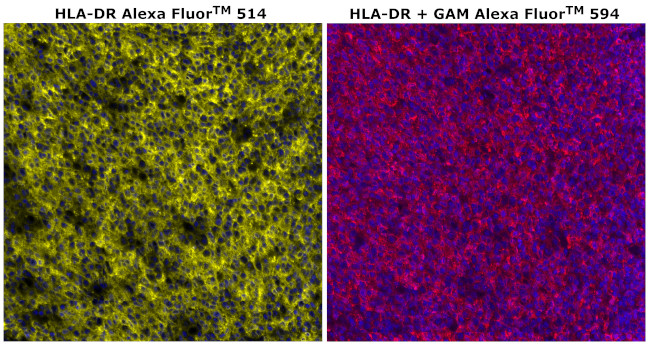FIGURE: 1 / 3
HLA-DR Antibody (753-9956-82) in IHC (P)



Product Details
753-9956-82
Species Reactivity
Host/Isotype
Class
Type
Clone
Conjugate
Excitation/Emission Max
Form
Concentration
Purification
Storage buffer
Contains
Storage conditions
Shipping conditions
Product Specific Information
Description: The LN3 antibody reacts with the human major histocompatibility complex (MHC) class II, HLA-DR. HLA-DR is expressed on the surface of human antigen presenting cells (APC) including B cells, monocytes, macrophages, DCs, and activated T cells. HLA-DR is a heterodimeric transmembrane protein composed of alpha and beta subunits and plays an important role in the presentation of peptides to CD4^+ T lymphocytes.
Applications Reported: The LN3 antibody has been reported for use in flow cytometric analysis, and immunohistochemical staining. Immunohistochemistry can be performed using frozen and Bouin's, or formalin/paraffin, human tissues.
Applications Tested: This LN3 antibody has been tested by immunohistochemistry of formalin-fixed paraffin embedded tissue using high pH antigen retrieval and can be used at 10 µg/mL. It is recommended that the antibody be carefully titrated for optimal performance in the assay of interest.
Using conjugate solutions: Centrifuge the protein conjugate solution briefly in a microcentrifuge before use; add only the supernatant to the experiment. This step will help eliminate any protein aggregates that may have formed during storage, thereby reducing nonspecific background staining.
Target Information
HLA-DR, like other MHC class II molecules, is a transmembrane glycoprotein composed of a 36 kDa alpha chain (DRA) and 27 kDa beta chain (DRB). The alpha chain gene contains 5 exons. Exon 1 encodes the leader peptide, exons 2 and 3 encode the two extracellular domains, and exon 4 encodes the transmembrane domain and the cytoplasmic tail. DRA does not have polymorphisms in the peptide binding part and acts as the sole alpha chain for DRB1, DRB3, DRB4 and DRB5. Within the DR molecule the beta chain contains all the polymorphisms specifying the peptide binding specificities. Hundreds of DRB1 alleles have been described and typing for these polymorphisms is routinely done for bone marrow and kidney transplantation. HLA-DR is expressed primarily on antigen presenting cells such as B lymphocytes, monocytes, macrophages, thymic epithelial cells and activated T lymphocytes. Three loci, DR, DQ and DP, encode the major expressed products of the human class II region. The human MHC class II molecules bind intracellularly processed peptides, present them to T-helper cells, and have a critical role in the initiation of the immune response.
HLA and MHC antibodies play a significant role in Immunopeptidomics, facilitating the identification and characterization of neoantigens through high-performance liquid chromatography coupled to tandem Mass Spectrometry.
For Research Use Only. Not for use in diagnostic procedures. Not for resale without express authorization.
References (0)
Bioinformatics
Protein Aliases: CD74; CD74 antigen; CD74 antigen (invariant polypeptide of major histocompatibility complex, class II antigen-associated); CD74 molecule, major histocompatibility complex, class II invariant chain; DASS-397D15.1; DR beta-5; DR-9; DR2-beta-2; DR7; DR9; DRB1 transplantation antigen; Dw2; DW2.2/DR2.2; FLJ51114; FLJ75017; FLJ76359; gamma chain of class II antigens; histocompatibility antigen HLA-DR alpha; HLA class II histocompatibility antigen gamma chain; HLA class II histocompatibility antigen, DR alpha chain; HLA class II histocompatibility antigen, DR beta 3 chain; HLA class II histocompatibility antigen, DR beta 4 chain; HLA class II histocompatibility antigen, DR beta 5 chain; HLA class II histocompatibility antigen, DR-1 beta chain; HLA class II histocompatibility antigen, DR-5 beta chain; HLA class II histocompatibility antigen, DRB1 beta chain; HLA class II histocompatibility antigen, DRB1-7 beta chain; HLA class II histocompatibility antigen, DRB1-9 beta chain; HLA-DR antigens-associated invariant chain; HLA-DR-gamma; HLA-DRB1; HLA-DRB5; human leucocyte antigen DRB1; human leucocyte antigen DRB3; human leucocyte antigen DRB4; human leucocyte antigen DRB5; Human leukocyte antigen DRB1; Ia antigen-associated invariant chain; Ia-associated invariant chain; Ii; leukocyte antigen; leukocyte antigen class II; lymphocyte antigen DRB1; MHC cell surface glycoprotein; MHC class I antigen; MHC Class II antigen; MHC class II antigen DR beta 3 chain; MHC class II antigen DRA; MHC class II antigen DRB1*9; MHC class II antigen DRB3; MHC class II antigen DRB4; MHC class II antigen DRB5; MHC class II antigen HLA-DR-beta; MHC class II HLA beta chain; MHC class II HLA-DR beta 1 chain; MHC class II HLA-DR beta 3 chain; MHC class II HLA-DR-beta cell surface glycoprotein; MHC class II HLA-DRw10-beta; MHC class2 antigen; MHC HLA DR-beta chain; MHC HLA-DR gamma chain; MHC HLA-DR-beta cell surface glycoprotein; MHC HLA-DR-beta chain; p33; XXbac-BPG161M6.1
Gene Aliases: CD74; DHLAG; DR-4; DR4; DRB1; DRB4; DRw10; HLA-DR1B; HLA-DR3B; HLA-DR4B; HLA-DRA; HLA-DRA1; HLA-DRB; HLA-DRB1; HLA-DRB3; HLA-DRB4; HLA-DRB5; HLADG; Ia-GAMMA; II; MLRW; SS1
UniProt ID: (Human) P04233, (Human) P01903, (Human) Q5UBA2, (Human) P79483, (Human) P13762, (Human) Q30154
Entrez Gene ID: (Human) 972, (Human) 3122, (Human) 3123, (Human) 3125, (Human) 3126, (Human) 3127

Performance Guarantee
If an Invitrogen™ antibody doesn't perform as described on our website or datasheet,we'll replace the product at no cost to you, or provide you with a credit for a future purchase.*
Learn more
We're here to help
Get expert recommendations for common problems or connect directly with an on staff expert for technical assistance related to applications, equipment and general product use.
Contact tech support

